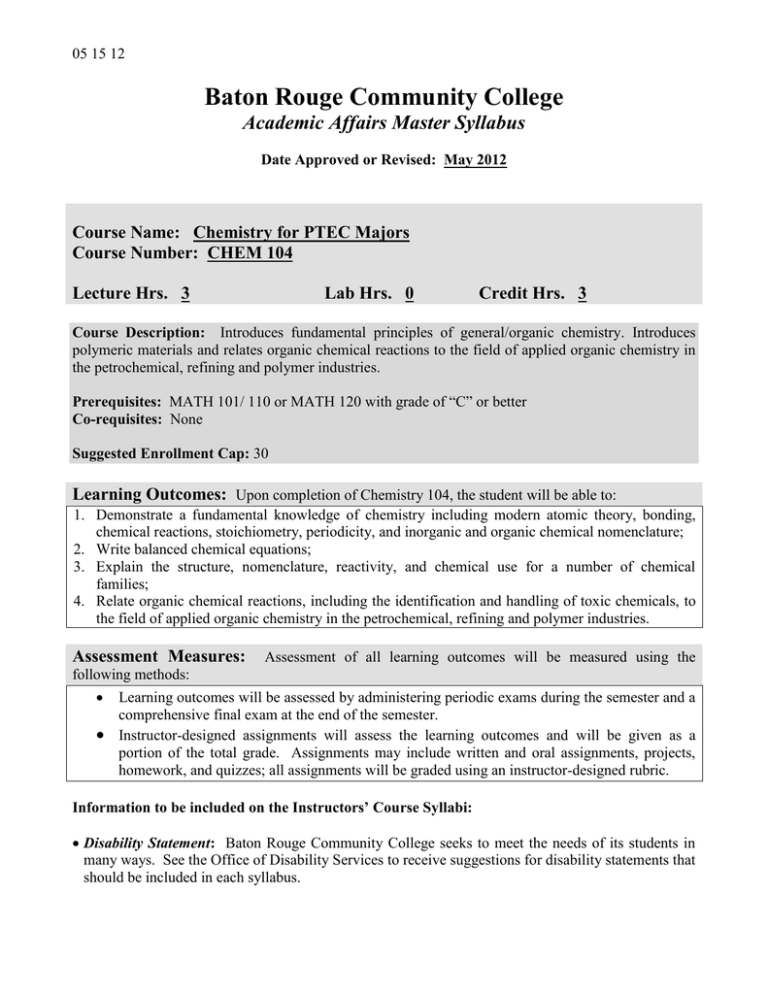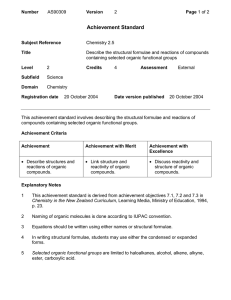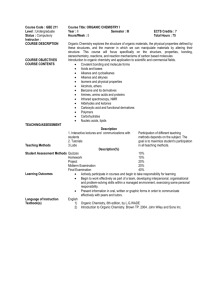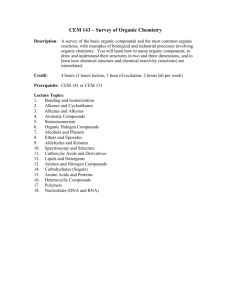Baton Rouge Community College Academic Affairs Master Syllabus
advertisement

05 15 12 Baton Rouge Community College Academic Affairs Master Syllabus Date Approved or Revised: May 2012 Course Name: Chemistry for PTEC Majors Course Number: CHEM 104 Lecture Hrs. 3 Lab Hrs. 0 Credit Hrs. 3 Course Description: Introduces fundamental principles of general/organic chemistry. Introduces polymeric materials and relates organic chemical reactions to the field of applied organic chemistry in the petrochemical, refining and polymer industries. Prerequisites: MATH 101/ 110 or MATH 120 with grade of “C” or better Co-requisites: None Suggested Enrollment Cap: 30 Learning Outcomes: Upon completion of Chemistry 104, the student will be able to: 1. Demonstrate a fundamental knowledge of chemistry including modern atomic theory, bonding, chemical reactions, stoichiometry, periodicity, and inorganic and organic chemical nomenclature; 2. Write balanced chemical equations; 3. Explain the structure, nomenclature, reactivity, and chemical use for a number of chemical families; 4. Relate organic chemical reactions, including the identification and handling of toxic chemicals, to the field of applied organic chemistry in the petrochemical, refining and polymer industries. Assessment Measures: Assessment of all learning outcomes will be measured using the following methods: Learning outcomes will be assessed by administering periodic exams during the semester and a comprehensive final exam at the end of the semester. Instructor-designed assignments will assess the learning outcomes and will be given as a portion of the total grade. Assignments may include written and oral assignments, projects, homework, and quizzes; all assignments will be graded using an instructor-designed rubric. Information to be included on the Instructors’ Course Syllabi: Disability Statement: Baton Rouge Community College seeks to meet the needs of its students in many ways. See the Office of Disability Services to receive suggestions for disability statements that should be included in each syllabus. 05 15 12 Grading: The College grading policy should be included in the course syllabus. Any special practices should also go here. This should include the instructor’s and/or the department’s policy for make-up work. For example in a speech course, “Speeches not given on due date will receive no grade higher than a sixty” or “Make-up work will not be accepted after the last day of class.” Attendance Policy: Include the overall attendance policy of the college. Instructors may want to add additional information in individual syllabi to meet the needs of their courses. General Policies: Instructors’ policy on the use of things such as beepers and cell phones and/or hand held programmable calculators should be covered in this section. Cheating and Plagiarism: This must be included in all syllabi and should include the penalties for incidents in a given class. Students should have a clear idea of what constitutes cheating in a given course. Safety Concerns: In some programs this may be a major issue. For example, “No student will be allowed in the safety lab without safety glasses.” General statements such as, “Items that may be harmful to one’s self or others should not be brought to class.” Library/ Learning Resources: Since the development of the total person is part of our mission, assignments in the library and/or the Learning Resources Center should be included to assist students in enhancing skills and in using resources. Students should be encouraged to use the library for reading enjoyment as part of lifelong learning. Expanded Course Outline: I. Measurement A. Units of Measurement B. Measured Numbers and Significant Figures C. Significant Figures in Calculations D. Prefixes and Equalities E. Problem Solving Using Conversions Factors F. Density G. Temperature II. Atoms and Elements A. Elements and Symbols B. The Periodic Table C. The Atom D. Atomic Number and Mass Number E. Isotopes F. Electron Energy Levels III. Compounds and Their Bonds A. Valence Electrons B. Octet Rule and Ions C. Ionic Compounds 05 15 12 D. E. F. G. H. Naming Ionic Compounds Polyatomic Ions Covalent Compounds Bond Polarity Shapes and Polarity of Molecules IV. Chemical Reactions and Quantities A. Chemical Changes B. Chemical Equations C. Types of Reactions D. Oxidation-Reduction Reactions E. The Mole F. Molar Mass G. Mole Relationships in Chemical Equations H. Mass Calculations for Reactions V. Solutions A. Types of Solutions B. Formations of Solutions C. Solubility and Saturated Solutions D. Electrolytes E. Percent Concentration F. Molarity and Dilution G. Colloids and Suspensions VI. Acids and Bases A. Acids and Bases B. Bronsted-Lowry Acids and Bases C. Strengths of Acids and Bases D. Ionization of Water E. The pH Scale F. Reactions of Acids and Bases G. Buffers and Indicators VII. Introduction to Organic Chemistry A. Organic Compounds B. Bonding in Organic Compounds C. Alkanes D. Naming Alkanes E. Haloalkanes F. Properties of Alkanes G. Functional Groups VIII. Unsaturated Hydrocarbons A. Alkenes and Alkynes B. Naming Alkenes and Alkynes C. Cis-Trans Isomers D. Addition Reactions 05 15 12 E. Polymers of Alkenes F. Aromatic Compounds IX. Organic Compounds with Oxygen and Sulfur A. Alcohols, Phenols, Thiols and Epoxides B. Some Important Alcohols, Phenols, Polyols and Polyphenols C. Ethers and Polyethers D. Epoxides and Polymeric Epoxy Resins E. Properties of Alcohols, Phenols, Ethers and Epoxides F. Reactions of Alcohols, Thiols and Epoxides G. Aldehydes and Ketones H. Some Important Ketones and Aldehydes I. Properties of Ketones and Aldehydes X. Carboxylic Acids, Esters, Amines and Amides A. Carboxylic Acids B. Properties and Reactions of Carboxylic Acids C. Acidity of Carboxylic Acids D. Esters and Polyesters E. Properties of Esters F. Amines and Isocyanates G. Properties and Reactions of Amines, Polyamines and Isocyanates H. Amides, Polyamides and Polyurethanes XI. Other Polymers, Properties and Applications A. Polymeric Materials Testing B. Polymeric Materials Processing C. Polymeric Materials Applications D. Polymer Synthesis Reactions from various Functional Groups






